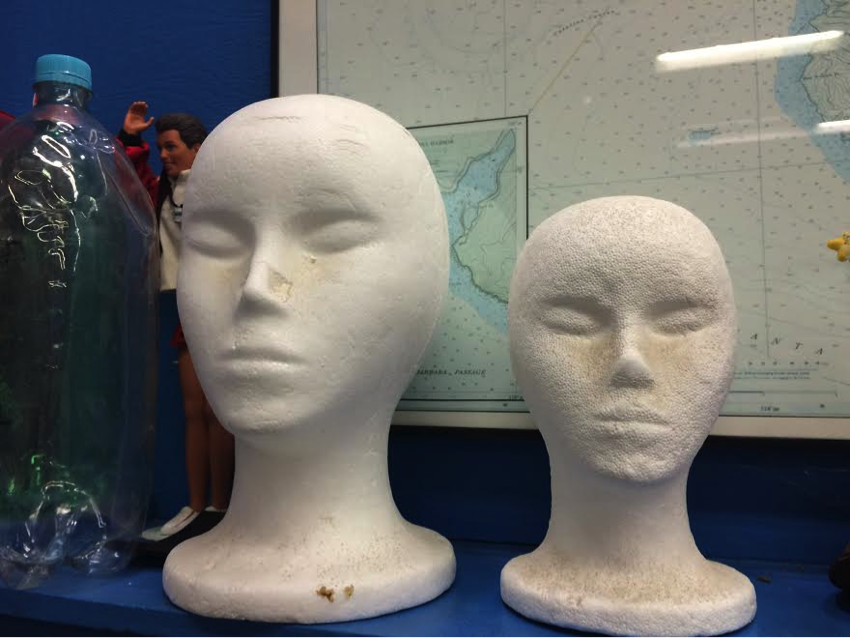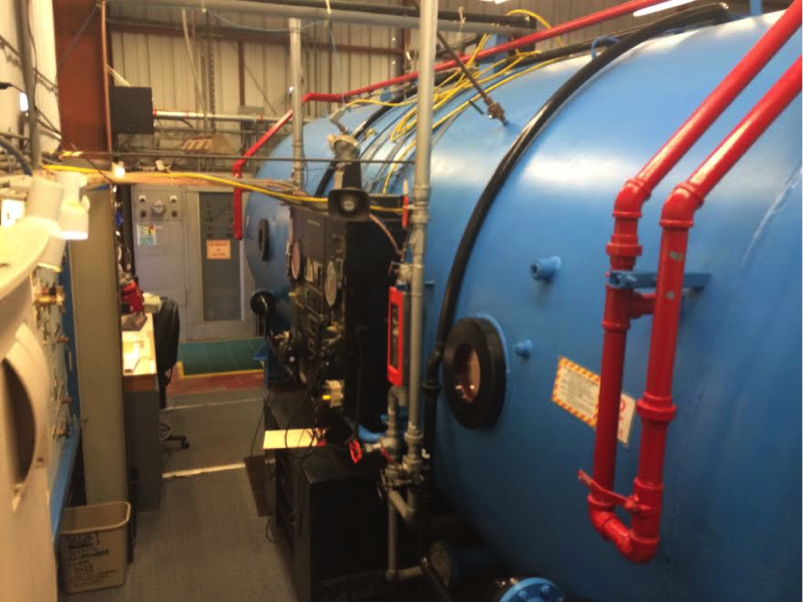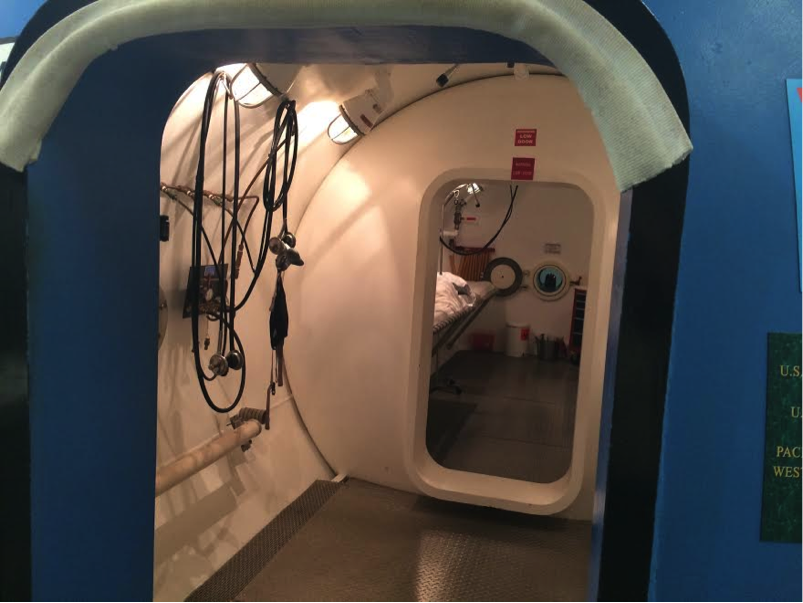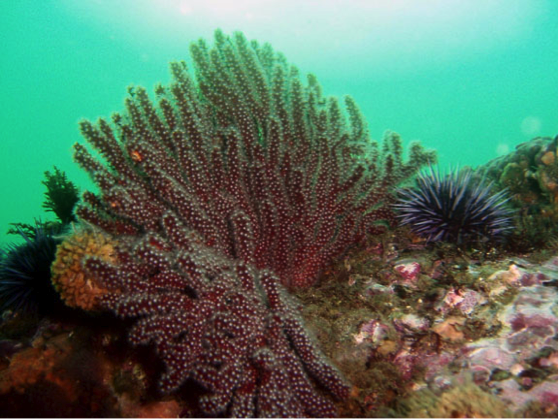By: Elise Steinberger
A few days ago, I managed to find my way into a tour of the Catalina Hyperbaric Chamber. I had met briefly with Lorraine Sadler to discuss an upcoming kayaking and snorkeling excursion, and she mentioned that she needed to hurry back for the 2 o’clock Hyperbaric Chamber tour. Turns out, in addition to being a WIES Education Specialist, Lorraine is a Chamber Technician and experienced diver. As an amateur diver myself, the idea of seeing how a hyperbaric chamber worked sparked my interest.
At the start of my internship with the Wrigley Institute, I had been given a waterfront orientation and heard about the Hyperbaric Chamber. However, the Chamber remained the mysterious unicorn of WIES – a place I heard stories of, but never seen in action. I casually asked Lorraine who the tour was for and she invited me to join. Forty minutes later, I was in a semi-circle of people listening intently as the facilities were described.
Here’s the science: As divers breath air under water, more gas dissolves into the tissues of their bodies due to the higher pressures underwater. When the diver surfaces, these dissolved gases should be expelled through the lungs. However, when a diver ascends too quickly, the dissolved gas can bubble out of solution in the body before it can be exhaled. Having these gas bubbles in your tissues is extremely dangerous and can block arteries or veins, causing an embolism. Thus, treating a diver with decompression sickness or an embolism involves integrating knowledge of the human body with the basic physics principles of gases under pressure.
To the layperson, the Hyperbaric Chamber looks like a large, blue submarine – complete with little round windows. The Chamber is 25 feet long and 9 feet in diameter and can simulate the pressure of dives as deep as 165 feet. Operators accomplish this pressure change by pumping air into the sealed chamber until the desired pressure is reached. The Chamber is ready for emergencies at a moment’s notice, and staffed by a rotating crew of local and global volunteers 24 hours a day, all year. Moreover, a backup generator allows the Chamber to function even in the case of power outages.
After hearing an overview of the functions of the Chamber, we were invited to step inside to ‘test it out.’ We filed into the Chamber and shut the 400-pound door behind us. As we stood inside, we learned how they operated the Chamber, what medical supplies were available, and heard stories of lives saved. After a few moments, a volunteer operating the chamber on the outside communicated to us – via a telephone on the wall – that we would be going ‘down’ to one foot. Sure enough, as they pumped air into the Chamber it felt just like diving, as my ears verified to me that the pressure was increasing.
At a ‘depth’ of one foot, we were instructed to try opening the door. As the person standing closest to it, I gave it a whirl. After a joke or two about asking the smallest person in the Chamber to try opening the sealed door, the man standing next to me also tried to muscle it open. Needless to say, the increased pressure in the Chamber meant the door was firmly shut.
I spoke at length with Max Brummett, a Physician’s Assistant from the mainland of California and the volunteer who operated the Chamber during our tour. He explained more about the Chamber and its volunteer program. Max comes here to Catalina for a few days at a time, working a ‘shift’ at the Chamber and waiting on stand-by for any emergencies. Max was familiar with the ins and outs of the Chamber and was enthusiastic to share his experiences as a volunteer.
I was intrigued to learn from Max that the Chamber was once used to support test pilots when trying their SST and SR-71 prototypes. Historically, sterile hyperbaric chambers have also been used to treat burn victims as the environment can accelerate the tissue recovery process. The Catalina Hyperbaric Chamber, in particular, was home to the hyperbaric and decompression research done by Dr. Andrew Pilmanis – an assistant professor of physiology – that led to the implementation of the standard 15-foot safety stop used by divers today.

A comparison of two Styrofoam heads – both initially the same size – after one was compressed during a pressurized ‘dive’ in the Chamber.
Max explained how this living piece of history is used to treat patients. He explained that all staff involved in the treatment process are well equipped to confidently handle an emergency. Also, he said that any doctors that stay with the patient inside the Chamber and ‘dive’ down to depth are not allowed to make decisions about the course of treatment. As Max explained, this is a precautionary measure in case the doctor inside the Chamber experiences a foggy mind as a result of mild nitrogen narcosis.
I was impressed that, even if the patient receives hours and hours of treatment, he or she is never left alone. For this reason, volunteers are crucial to the operation of the Chamber. The Chamber and its crew have performed almost 1000 treatments since it was ‘opened’ in 1974. To build on the volunteer base, people from all professional backgrounds – divers or not – are encouraged to go through training and donate a few days each year to help run the Chamber. This page explains how to become involved as a Chamber volunteer!
Elise Steinberger is a fall intern at the Wrigley Institute, learning more about marine science before beginning her Master’s in Health and Science Writing at Northwestern University.




